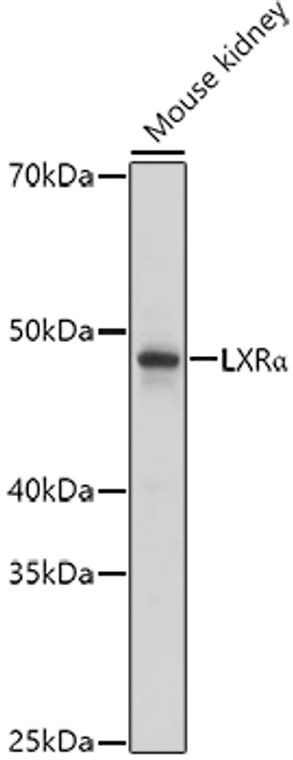| Host: |
Rabbit |
| Applications: |
WB |
| Reactivity: |
Human/Mouse/Rat |
| Note: |
STRICTLY FOR FURTHER SCIENTIFIC RESEARCH USE ONLY (RUO). MUST NOT TO BE USED IN DIAGNOSTIC OR THERAPEUTIC APPLICATIONS. |
| Short Description: |
Rabbit polyclonal antibody anti-LXR Alpha (160-230) is suitable for use in Western Blot research applications. |
| Clonality: |
Polyclonal |
| Conjugation: |
Unconjugated |
| Isotype: |
IgG |
| Formulation: |
PBS with 0.01% Thimerosal, 50% Glycerol, pH7.3. |
| Purification: |
Affinity purification |
| Dilution Range: |
WB 1:500-1:1000 |
| Storage Instruction: |
Store at-20°C for up to 1 year from the date of receipt, and avoid repeat freeze-thaw cycles. |
| Gene Symbol: |
NR1H3 |
| Gene ID: |
10062 |
| Uniprot ID: |
NR1H3_HUMAN |
| Immunogen Region: |
160-230 |
| Immunogen: |
Recombinant fusion protein containing a sequence corresponding to amino acids 160-230 of human LXR Alpha (NP_005684.2). |
| Immunogen Sequence: |
QAGMREECVLSEEQIRLKKL KRQEEEQAHATSLPPRASSP PQILPQLSPEQLGMIEKLVA AQQQCNRRSFS |
| Tissue Specificity | Visceral organs specific expression. Strong expression was found in liver, kidney and intestine followed by spleen and to a lesser extent the adrenals. |
| Post Translational Modifications | Ubiquitinated leading to its degradation by the proteasome. |
| Function | Nuclear receptor that exhibits a ligand-dependent transcriptional activation activity. Interaction with retinoic acid receptor (RXR) shifts RXR from its role as a silent DNA-binding partner to an active ligand-binding subunit in mediating retinoid responses through target genes defined by LXRES. LXRES are DR4-type response elements characterized by direct repeats of two similar hexanuclotide half-sites spaced by four nucleotides. Plays an important role in the regulation of cholesterol homeostasis, regulating cholesterol uptake through MYLIP-dependent ubiquitination of LDLR, VLDLR and LRP8. Interplays functionally with RORA for the regulation of genes involved in liver metabolism. Induces LPCAT3-dependent phospholipid remodeling in endoplasmic reticulum (ER) membranes of hepatocytes, driving SREBF1 processing and lipogenesis. Via LPCAT3, triggers the incorporation of arachidonate into phosphatidylcholines of ER membranes, increasing membrane dynamics and enabling triacylglycerols transfer to nascent very low-density lipoprotein (VLDL) particles. Via LPCAT3 also counteracts lipid-induced ER stress response and inflammation, likely by modulating SRC kinase membrane compartmentalization and limiting the synthesis of lipid inflammatory mediators. |
| Protein Name | Oxysterols Receptor Lxr-AlphaLiver X Receptor AlphaNuclear Receptor Subfamily 1 Group H Member 3 |
| Database Links | Reactome: R-HSA-1989781Reactome: R-HSA-383280Reactome: R-HSA-4090294 Q13133-1Reactome: R-HSA-8866427Reactome: R-HSA-9029558Reactome: R-HSA-9029569Reactome: R-HSA-9031525Reactome: R-HSA-9031528Reactome: R-HSA-9623433Reactome: R-HSA-9632974 |
| Cellular Localisation | NucleusCytoplasm |
| Alternative Antibody Names | Anti-Oxysterols Receptor Lxr-Alpha antibodyAnti-Liver X Receptor Alpha antibodyAnti-Nuclear Receptor Subfamily 1 Group H Member 3 antibodyAnti-NR1H3 antibodyAnti-LXRA antibody |
Information sourced from Uniprot.org
12 months for antibodies. 6 months for ELISA Kits. Please see website T&Cs for further guidance






